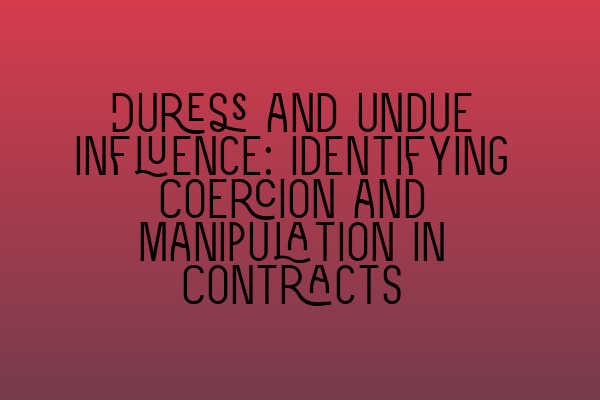Duress and Undue Influence: Identifying Coercion and Manipulation in Contracts
Contracts play a crucial role in shaping the legal landscape of business transactions and personal agreements. They establish the rights and obligations of parties involved and provide a framework for smooth operations. However, certain situations may arise where one party is coerced or manipulated into entering into a contract against their will or better judgment. In such cases, the contracts may be deemed unenforceable due to duress or undue influence. This blog post will explore the concepts of duress and undue influence, and provide a guide on how to identify coercion and manipulation in contracts.
What is Duress?
Duress refers to the act of intentionally using force, threats, or psychological pressure to compel someone to enter into a contract. In such cases, the consent of the person subjected to duress is not genuine, as they are acting under fear or intimidation. Contracts entered into under duress are considered voidable, meaning the innocent party has the option to either affirm or cancel the contract.
There are two types of duress: physical duress and economic duress. Physical duress involves direct threats or physical harm to pressure someone into entering into a contract. On the other hand, economic duress involves exploiting another party’s financial vulnerability or creating circumstances where they have no other choice but to accept unfavorable contract terms.
Identifying Duress in Contracts
To identify duress in contracts, it is essential to look for signs of coercion and lack of genuine consent. Some common indicators include:
1. Threats of harm: Contracts entered into under the threat of physical violence or property damage are likely to be tainted by duress.
2. Undue pressure: If one party excessively pressures the other to sign the contract without allowing them enough time for careful consideration, it may indicate duress.
3. Exploitation of vulnerabilities: Contracts that take advantage of another party’s financial or emotional vulnerabilities can be indicative of duress.
4. Unfair terms: If the contract terms significantly favor one party while burdening the other, it may raise suspicions of duress.
What is Undue Influence?
Undue influence occurs when someone uses their power, authority, or close relationship to manipulate another person’s decisions and actions, leading them to enter into a contract against their best interests. The party exerting undue influence takes advantage of their position to exploit the weaker party’s trust, dependency, or lack of independent judgment.
Undue influence can be categorized into two types: actual undue influence and presumed undue influence. Actual undue influence refers to direct evidence of manipulation, while presumed undue influence involves situations where the relationship or circumstances create a presumption of undue influence.
Identifying Undue Influence in Contracts
To identify undue influence in contracts, it is essential to consider the following factors:
1. Relationship between parties: If there is a confidential or fiduciary relationship between the parties, such as a doctor-patient or attorney-client relationship, it raises suspicions of undue influence.
2. Disparity in power: Significant differences in age, knowledge, or experience between the parties can indicate a power imbalance, which may lead to undue influence.
3. Isolation: If the weaker party is isolated from family and friends or has limited access to independent advice, it can make them more susceptible to undue influence.
4. Unfair or unequal terms: Contracts with terms that disproportionately favor the party exerting influence suggest potential undue influence.
Protecting Against Coercion and Manipulation
To protect against coercion and manipulation in contracts, it is crucial to take the following measures:
1. Seek legal advice: Consulting with a solicitor who specializes in contract law can help identify potential issues and provide guidance on protecting your interests.
2. Free and informed consent: Ensure that all parties involved in the contract provide their consent voluntarily, without any duress or undue influence.
3. Independent advice: Encourage the weaker party to seek independent legal, financial, or emotional advice to ensure they fully understand the contract terms and implications.
4. Review contract terms: Carefully review all contract terms to ensure they are fair, reasonable, and do not disproportionately favor one party over the other.
Conclusion
Duress and undue influence can undermine the fairness and validity of contracts. It is crucial to be vigilant and identify signs of coercion and manipulation in contracts to protect your rights and interests. By understanding the concepts of duress and undue influence and taking proactive measures, you can ensure that your contracts are entered into freely and without undue pressure or manipulation.
Related Articles:
– SQE 1 Practice Exam Questions
– SQE 1 Practice Mocks FLK1 FLK2
– SQE 2 Preparation Courses
– SQE 1 Preparation Courses
– SRA SQE Exam Dates
